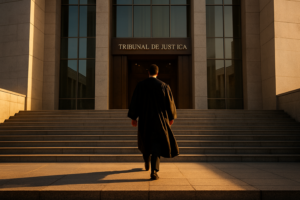Preparing a company’s CEO for testimony in a police inquiry begins with an essential acknowledgment: most executives are caught by surprise when summoned and react with apprehension — “What does the police want from me?” “What is this inquiry about?”
Summonses usually indicate only the case number, the police authority, and the clerk, without detailing the subject under investigation. Therefore, the first step is to immediately appoint a trusted criminal lawyer.
This professional will assess whether the appearance will be as a witness or as a suspect, identify the scope of the investigation, and outline the most appropriate defense strategy for the case.
First Step: Access to the Case Files and Definition of Strategy
The criminal lawyer formalizes the power of attorney, requests access to the case files, and may request rescheduling of the hearing when necessary.
Once the documents are in hand, it becomes possible to determine the executive’s procedural position and understand the investigative line.
At this stage, CNMP Resolution No. 181/2017 applies, which governs investigative procedures during the pre-procedural phase, guaranteeing rights and guiding conduct.
Witness vs. Suspect: Rights and Limits
The distinction between witness and suspect is central:
- A witness has the legal duty to tell the truth and respond objectively, without omitting relevant facts.
- A suspect has the right to remain silent and not to self-incriminate — which does not imply guilt but represents the legitimate exercise of a constitutional guarantee.
When there is doubt about the procedural status, it is advisable to avoid unnecessary exposure until the defense has full access to the case files.
Internal Mapping and Timeline of Facts
Preparation for testimony should include a structured internal mapping, addressing questions such as:
- Does the CEO have direct knowledge of the facts or rely on technical information?
- Which areas hold sensitive data (financial, tax, environmental, compliance)?
- Which managers and employees can assist in understanding the chronology of events?
- Which documents help reconstruct the context (contracts, emails, reports)?
This assessment allows for the construction of a question-and-answer script and identification of potential critical points.
In some cases, it may be prudent to present documents in a coordinated manner, outside the hearing, accompanied by a technical explanatory note.
When to Speak — and When to Exercise the Right to Remain Silent
The decision to provide testimony should be based on the degree of risk identified in the case files.
In early stages, speaking without understanding the context may open new lines of investigation.
On the other hand, when the hearing is technical and well-defined, precise and objective answers help shorten the procedure.
The balance lies in combining clarity, restraint, and risk control.
Documents, Versions, and Governance
Document management is part of the technical defense. Attaching documents without strategic alignment can lead to distorted interpretations.
Coordinated presentation — with indexing and technical explanation — ensures coherence and prevents gaps.
In complex cases, defensive investigation, a tool provided for in OAB Provision No. 188/2018, may be advisable, allowing for the structured collection of technical evidence.
Legal Assistance and Institutional Perception
Attending with a criminal lawyer is not a sign of guilt but of institutional responsibility.
The professional’s ethical reputation and relationship with authorities strengthen the credibility of the testimony and protect the client from misinterpretations.
The goal is to respond accurately, safeguard rights, and preserve the company’s image.
Conclusion: Method and Composure
Testimonies in police inquiries require technical preparation, strategy, and composure.
When the summoned person holds a leadership position — such as a CEO — every answer can reflect on both personal and institutional reputation.
Therefore, the preventive role of the criminal lawyer is the decisive factor between a controlled hearing and an unnecessary exposure scenario.
More than merely reacting to a summons, the executive must understand that the right of defense begins before speaking: with access to the case files, internal fact mapping, and a clear definition of conduct.
Acting methodically and under proper legal guidance demonstrates corporate responsibility and reduces legal and reputational risks.
Proper preparation is, ultimately, the best way to protect both the company and the integrity of the narrative.



